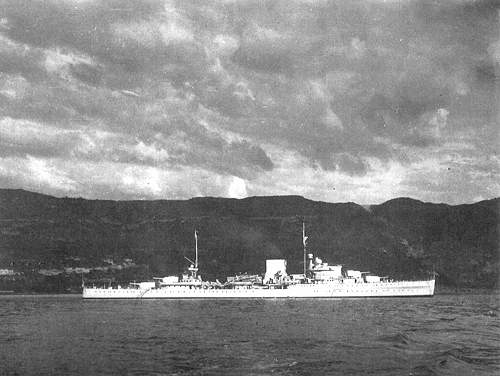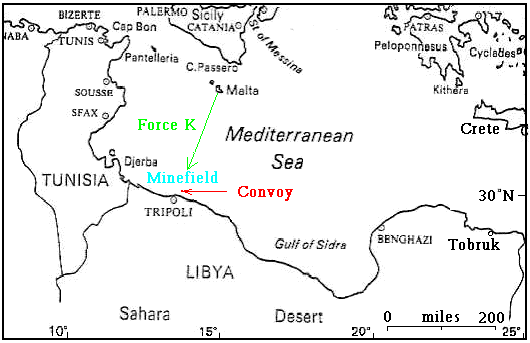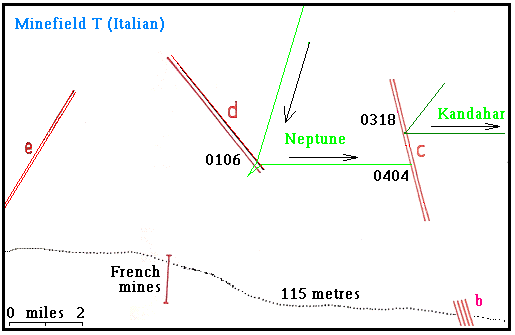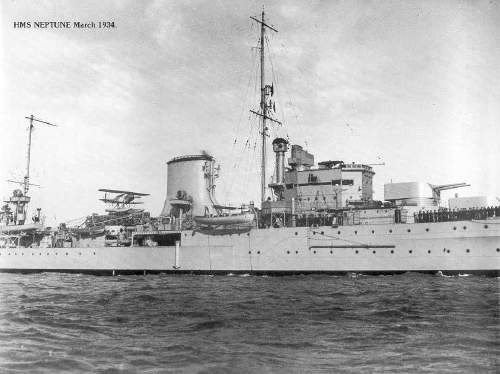 | |
|
The loss of 837 men from HM Ships
NEPTUNE and KANDAHAR in 1941
More than 70 years ago on the night of 19 December 1941, there occurred one of the most extensive but least known naval disasters of the Second World War. The Cruiser HMS Neptune ran into an uncharted minefield in the Mediterranean off Tripoli, and sank with the loss of 764 officers and men. Just one man was rescued by an Italian torpedo boat, after 5 days in the water.
| 
HMS Neptune, commanded by Captain Rory O'Conor, was leading 'Force K', a Cruiser raiding squadron. Their task was to destroy German and Italian convoys carrying troops and supplies to Libya, in support of Rommel's army in North Africa. On the afternoon of December 18th the squadron was despatched from Malta to intercept an important enemy convoy bound for Tripoli. The three cruisers of 'Force K', the Neptune, Aurora and Penelope, supported by the destroyers Kandahar, Lance, Lively and Havock, were steaming south, in single line ahead on a dark, stormy night when at 0106 am, the Neptune struck a mine. The Aurora her next astern, hauled out to starboard but only a minute later she too exploded a mine; two minutes later an explosion buffeted Penelope's port side abreast the bridge. The Neptune going full astern hit another mine, which wrecked her steering gear and propellers and brought her to a standstill. The cruiser force had run into a minefield in a depth of water and at a distance from land which made it utterly unexpected.
MAP - MALTA to TRIPOLI
This map shows the route taken by Force K on December 18th 1941.
| 
The Aurora contrived to turn and steam out of the field without further catastrophe, followed by the Penelope; Captain Agnew, in command of Aurora considered the situation in all its dire gravity. They were 15 miles from Tripoli and it was nearly dawn. The damage to Aurora had reduced her maximum speed to 10 knots, and his duty was to get her as far from the enemy coast as he could before daylight. The risk of sending another ship into the minefield to tow the Neptune out was hardly justified but the need to save life made it imperative.
The destroyers Kandahar and Lively then entered the minefield in an attempt to reach the Neptune and tow her out. Captain Nicholl was also cautiously edging the Penelope towards her when at 0318 the Kandahar struck a mine. Captain O'Conor of the Neptune flashed a warning : "Keep away". At 0403 she struck a fourth mine which exploded amidships. This was more than her hull could take; she slowly turned over and sank.
MAP - MINEFIELD "T"
Italian Minefield "T" showing detail of Minelanes "d" and "c"
and the drift of Neptune and Kandahar after hitting the mines.
| 
The Captain of the crippled Kandahar, made his last signal to the Penelope. "Suggest you should go" he said bluntly. "I clearly cannot help you" replied Captain Nicholl, "God be with you"; and to the Lively "course 0100 speed 15 knots."
The dawn found Kandahar still afloat but submerged from abaft the funnel. Of possible survivors from the Neptune, nothing could be seen. All day they waited and with the darkness the sea rose. It carried the Kandahar clear of the minefield, but she was listing ominously. Then at 4 a.m. the destroyer Jaguar, sent to the rescue from Malta, appeared out of the darkness. With Jaguar positioning herself upwind of the Kandahar, the ship's company jumped in the water, and as the Jaguar drifted slowly down towards them a total of 8 officers and 170 crew were pulled out, but 73 men had perished. With dawn breaking, the Jaguar fired a torpedo into the Kandahar to sink her and set out back to Malta.
|  |
THE SURVIVOR'S STORY
The one Neptune survivor, Able Seaman Norman Walton, spent 18 months in Italian prisoner of war camps before being released in 1943. On his return, he was closely questioned about the sinking and his story was this:
"We had been at action stations since 8 p.m., when just after midnight there was an explosion off our starboard bow. The captain stopped engines and went astern but we hit another mine, blowing the screws and most of the stern away. Then we were hit abaft the funnel. We were ordered up top and had a bad list to port and were down in the stern. Aurora had also been mined and badly damaged and Kandahar came up to take us in tow.
"With seven others, I was asked to go forward to help with the tow, but Kandahar then hit a mine and slewed off. Then we hit a fourth mine and we were lifted up and dropped back again. I got the Petty Officer of the forecastle from beneath the anchor chain but he had broken his back. Four of us Price, Middie the Midhipman, Quinn and me, climbed down the anchor. They jumped in but I wanted somewhere to swim to, and not to just float around, and when I saw a Carley raft I jumped in and swam to it.
"I took the tow rope back to Middie who had no lifejacket, and when we got back to the raft it was crowded - about 30 people on and around it. We saw the ship capsize and sink and gave her a cheer as she went down. We picked up Captain O'Conor who was clinging to what looked like an anchor buoy and he and three other officers finished up on a cork raft attached to ours. The sea was thick with oil and most of us had swallowed a lot of it. A few died around us that night and at daylight there were 16 of us left. The weather was pretty rough and two officers tried to swim towards the Kandahar but they never made it.
"Three more ratings died and we picked up an oar and I tried to steer the raft but could make no headway. By the fourth day there were only four of us left including the Captain who died that night. I was in the water for three days before being able to find room aboard the raft. Most of the lads just gave up the ghost but I was very fit because of playing so much sport and this is probably why I survived. I had a smashed leg and by Christmas Eve on the 5th day, there was only Price and myself left. I saw an aircraft; waved to it and an hour later an Italian torpedo boat came alongside and threw me a line. I collapsed when I got on board and woke up on Christmas Day in a Tripoli hospital. They told me Price was dead.
"I was totally blind throughout Christmas because of the oil and was praying it was only temporary. On Boxing Day I got my sight back and looked in a mirror. My tongue was swollen to twice its size and my nose spread across my face, which was black from the oil and from exposure. Still, apart from my broken leg I was almost back to normal by New Year's Day, when I was put on a ship bound for Italy and full of German and Italian troops going on leave.
"I spent 15 months in various prisoner-of-war camps until told I was going to be repatriated and arrived home in June 1943. The Italians had told me I was the only Neptune survivor, but I could never believe that until the Navy confirmed it for me in 1943. Sometimes even now it is hard to take in."
THE BOARD OF INQUIRY
A Board of Inquiry was held within a week of the disaster, on Wednesday 24th December 1941, on board HMS Ajax at Malta and after taking evidence from the witnesses the Board reported back to the Commander-in-Chief, Mediterranean on 8th January 1942. You can view a Full Transcript of the Board of Inquiry and related documents by clicking here
|
© 2002-2018 The Neptune Association, Registered Charity No 1103413. |